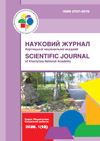APPLICATION OF THE "GOOD START" METHOD ELEMENTS IN THE FORMATION OF ENVIRONMENTAL CONCEPTS IN PRESCHOOL CHILDREN WITH INTELLECTUAL DISABILITIES
DOI : https://doi.org/10.51706/2707-3076-2025-12-13
Abstract
The article examines the technology of applying elements of the "Good Start" method (M. Bogdanowicz) in the process of forming environmental concepts in preschool children with intellectual disabilities. It has been proven that developing environmental concepts is a crucial stage in a preschooler's personality development, as it ensures awareness of fundamental relationships between objects and phenomena in the surrounding reality, establishes a foundation for ecological thinking, social adaptation, and the development of moral and ethical norms.
The purpose of the article is to study the application technology of the "Good Start" method elements (M. Bogdanowicz) in the process of forming environmental concepts in preschoolers with intellectual disabilities, justify the pedagogical conditions for its implementation, and present practical aspects of using this method through lesson plans within the educational area "Child in the Natural Environment."
The research methods included theoretical analysis, generalization, and systematization, the comparative method; the modeling method and the pedagogical design method.
The article highlights theoretical sensory, activity-based, and environmental approaches to forming natural science concepts in children during lessons within the educational line "Child in the Natural Environment." It also presents theoretical principles regarding the corrective orientation of education and upbringing of children with intellectual disabilities, its impact on development and socialization processes, and the pedagogical conditions for implementing the "Good Start" method in the educational process.
It has been established that lessons conducted using the "Good Start" method follow a fixed structure consisting of three stages. In the first stage, the teacher and child perform a series of preparatory exercises to develop spatial orientation and acquire the ability to organize movements sequentially. In the second stage, the teacher engages the child in motor, auditory-motor, and visual-auditory-motor exercises. In the third stage, the teacher encourages the child to perform relaxation exercises (massage, breathing exercises) and vocal-rhythmic exercises.
The article presents a detailed lesson plan on introducing preschoolers with intellectual disabilities to the environment using elements of the "Good Start" method by M. Bogdanowicz within the educational area "Child in the Natural Environment."


